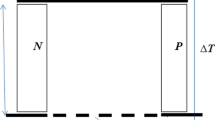Abstract
There is a significant amount of literature that discusses thermoelectric power generator (TEG) design, but much of it overly simplifies the design space and therefore the results have limited use in designing real-life systems. This paper develops a more comprehensive model of the thermal and electrical interactions of a TEG in a system with known hot-side and cold-side thermal resistances and corresponding constant system temperature differential. Two design scenarios are investigated for common TEG system applications. In one method, the power from a TEG is maximized for a given electrical load, simulating a case where the TEG is electrically in series with a known load such as a fan. In the second design scenario, the power from a TEG is maximized for a given electrical load resistance ratio, n (the ratio between the external load resistance and the internal TEG resistance), simulating an application where the TEG is electrically in series with a load-matching converter. An interesting conclusion from this work is that, in the first design scenario, the electrical load resistance ratio, n, that maximizes TEG power occurs at \( \sqrt {1 + ZT} \) (where ZT is the thermoelectric figure of merit) instead of 1 as reported previously in literature. Equally interesting is that, if you define an analogous thermal resistance ratio, m′ (representing the ratio between the TEG thermal resistance at open-circuit conditions and the system thermal resistance), the maximum power in both design scenarios occurs at \( \sqrt {1 + ZT} \) instead of the commonly cited value of 1. Furthermore, results are presented for real-life designs that incorporate electrical and thermal losses common to realistic TEG systems such as electrical contact resistance and thermal bypass around the TEG due to sealing.
Similar content being viewed by others
References
G.S. Nolas, J. Sharp, and H.J. Goldsmid, Thermoelectrics Basic Principles and New Materials Development (Berlin: Springer, 2001).
J. Steven, Optimized Thermal Design of Small Delta T Thermoelectric Generators. SAE Technical Paper 1999- 01-2564, (1991).
James. Stevens, Energy Convers. Manage. 42, 709 (1999).
G.J. Snyder, Energy Harvesting Technologies. s.l. Springer, 2009, Thermoelectric Energy Harvesting, pp. 325–336.
K. Yazawa and A. Shakouri, J. Appl. Phys. 111 (2012).
Author information
Authors and Affiliations
Corresponding author
Rights and permissions
About this article
Cite this article
McCarty, R. Thermoelectric Power Generator Design for Maximum Power: It’s All About ZT . J. Electron. Mater. 42, 1504–1508 (2013). https://doi.org/10.1007/s11664-012-2299-8
Received:
Accepted:
Published:
Issue Date:
DOI: https://doi.org/10.1007/s11664-012-2299-8




